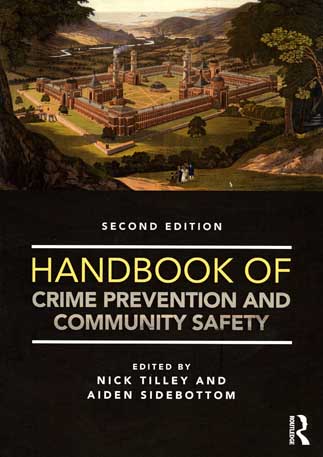Author: Nick Tilley and Aiden Sidebottom (editors)
ISBN No: 9781138851061
Review date: 18/04/2024
No of pages: 600
Publisher: Routledge
Publisher URL:
https://www.routledge.com/Handbook-of-Crime-Prevention-and-Community-Safety/Tilley-Sidebottom/p/book/9781138851061
Year of publication: 30/06/2017
Brief:
The second, revised edition of the Handbook of Crime Prevention and Community Safety is as welcome as the first, writes Mark Rowe.
This new edition, like the first, has a reassuringly heavy feel, and the reader is not disappointed in finding the contents as heavyweight, in a good sense. Each of the 26 chapters, of about 6000 words each, with full bibliographies, covers a topic, such as crime prevention through product design; and crime and the built environment. Some chapters naturally will be of more interest and use to the private security reader than others, such as Dr Matt Hopkins and Prof Martin Gill’s on ‘business, crime and crime prevention: emerging debates and future challenges’.
Given the sheer amount of work in bringing such a book together, it’s not bang up to date; the most recent citations and examples are from 2015. While that is only yesterday in academic terms, it can be more serious for instance in the chapter on vehicle crime. There Barry Webb and Rick Brown begin with the claim that vehicle crime has been ‘boom and bust’; namely a boom in the 20th century, leading to a peak in the early 1990s, and a rapid decline, ‘which, at the time of writing, had yet to abate’. That is to say the least arguable, given the prospect of cyber-vehicles that are like computers (with all the opportunities for hacking, and accessing keyless cars) and the organised and international theft, slaughtering and export of whole cars or parts. In fairness the authors do acknowledge that car manufacturers face an ‘arms race with offenders’. And for another thing, the security of parking of vehicles has been ‘piecemeal’, both in car parks and beside housing, where there’s a trade off between security and cost.
The same trade-off can be said for business crime, set out by Hopkins and Gill. Like other chapter authors they set out the field, drawing on more than UK examples and researchers. Chapter authors are from across the English-speaking world, notably North America, Australia and the UK. Hopkins and Gill conclude with some challenges – the different agendas of police and business, and how the tackling of crime in businesses is ‘problematic, because businesses exist to make profits and crime prevention will often take second place to that objective’. They identify also that corporate security heads, if from the uniformed services, armed forces and police, may be short of business skills and the ability to make their case to influence execs.
Some may find it surprising that only one chapter is devoted to cybercrime prevention, although cyber features in other chapters. Likewise, terrorism is little treated anywhere, though it’s for sure a crime that we want to prevent. But as with any book of this type, there’s only so much it can cover. Whether you want to think harder about your work, or you are taking a masters degree in risk and security management or a related subject, this is a go-to book, and shall remain so just as the first edition did for a dozen years.
At the risk of overlooking other chapters, one useful chapter to single out for the practitioner is Prof Gloria Laycock’s, titled ‘What to do – adopting a problem-oriented approach (POP)’, that indeed covers what practitioners ‘might do to reduce crime here and now – not somewhere one day’. Her chapter ranges over ‘what works’, CCTV, and crime and disorder in city centres by day and night. While POP is far from new, the chapter is a fine introduction to it, which goes for so much of the book as a whole.









